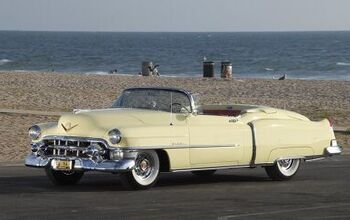Ford Finally Releases Specs, Says the GT Is the Fastest Thing It Has Ever Built

For the longest time, Ford was staunchly resistant to giving up details about the new Ford GT. With the automaker abandoning its 5.4 liter supercharged modular V8 for a 3.5 liter EcoBoost V6, everyone wanted to know the numbers. However, anytime someone asked for definitive specifications, Ford shrugged its shoulders. Then, today, the company gave us some numbers and proclaimed the second-generation 3.5-liter as its most powerful production EcoBoost to date, making the Ford GT the company’s fastest car to date.
Hold the phone. Are you telling us that the extremely expensive supercar that Ford specifically engineered to be the fastest vehicle in the company’s entire history somehow managed to out-perform cars like the Fiesta ST and Focus RS on a racetrack?
Absolutely incredible.
Peevishness aside, Ford says the new GT also bests the McLaren 675LT and Ferrari 458 Speciale on the Calabogie Motorsports Park race circuit by a fair margin. Calabogie is three-mile Canadian course with a lot of sweeping turns and some elevation changes that any of the three vehicles should have been adept at tackling. While it is safe to assume all of the vehicles were lapped using a driver on Ford’s payroll, the GT managed a 2:09.8 time — swift for any road vehicle on that particular circuit.
The technical specs are impressive, too. According to Ford, the GT’s powerband is wide enough to produce 90 percent of its 550 pounds-feet of torque at 3,500 rpm. Horsepower is a supercar-acceptable 647 ponies, propelling the vehicle to top speed of 216 miles an hour.
“The Ford GT is all about performance,” said Raj Nair, Ford’s executive VP for global product development and the chief technical officer. “We achieved considerable weight savings with the carbon fiber architecture. We then reinvested some of that savings into where it counts most – performance, specifically, the active dynamics. The result is an even faster car.”
Ford claims the model’s active-aero and smart suspension dynamics are designed to give the GT optimum downforce at any speed, giving novice and experience drivers an easier to work with setup.
If you’re looking for a power-to-weight ratio, it is my duty to tell you that we cannot give you one. Ford listed the GT’s dry weight as “just topping 3,000 pounds” and somewhere between a Ferrari 488 GTB and the aforementioned McLaren. My guess is that the Blue Oval’s indefinite answer to heft has something to do with a power-to-weight ratio that is slightly weaker than the 488’s.
Production of the GT is being handled by Multimatic, based in Markham, Ontario. Despite the limited production of 250 vehicles per year, the first units have already been delivered — perhaps one of those owners would be kind enough to weigh one.
[Image: Ford Motor Co.]

Consumer advocate tracking industry trends and regulations. Before joining TTAC, Matt spent a decade working for marketing and research firms based in NYC. Clients included several of the world’s largest automakers, global tire brands, and aftermarket part suppliers. Dissatisfied, he pivoted to writing about cars. Since then, he has become an ardent supporter of the right-to-repair movement, been interviewed about the automotive sector by national broadcasts, participated in a few amateur rallying events, and driven more rental cars than anyone ever should. Handy with a wrench, Matt grew up surrounded by Detroit auto workers and learned to drive by twelve. A contrarian, Matt claims to prefer understeer and motorcycles.
More by Matt Posky
Latest Car Reviews
Read moreLatest Product Reviews
Read moreRecent Comments
- MaintenanceCosts I've had my Highlander Hybrid for 5 1/2 years (although I'm the second owner) and it just keeps going with routine maintenance. I'm sure I could keep it another ten years if I wanted to.
- Redapple2 7 of 10 are Toyota products. 0 /10 are from the evil -gm- vampire. What can we deduce?
- SCE to AUX Direct sales will be a nice touch. https://insideevs.com/news/738666/scout-direct-to-consumer-sales/
- SCE to AUX They look great, and the new drivetrains will be better than anything IH had in the past. My recollection of IH vehicles was their unreliability and rust issues. Sentimentality over the IH brand is pretty thick, but TTAC is they were not great vehicles and the brand deserved to die when it did.
- 3SpeedAutomatic What If Scenario:When VW purchased Navistar, they also got the Travelall as well as the Scout brands. I would like to see a Travelall EV to compete with the Ford Exposition and Chevy Suburban/Tahoe. I understand that Rivian R1S is supposed to handle this in a up scale market, but a Travelall would pull in more the middle class late adopters sitting on the sidelines. 🚗🚗🚗


































Comments
Join the conversation
Nice Taurus V6 powered Ford.
But can it beat the old tech Viper ACR around a track?